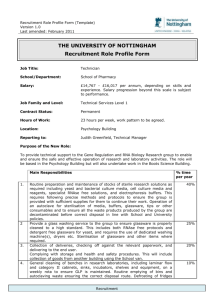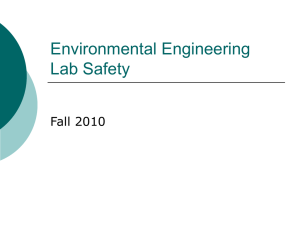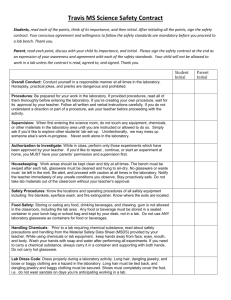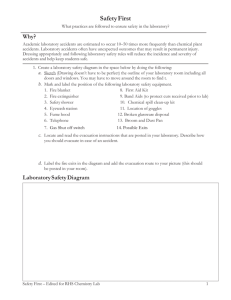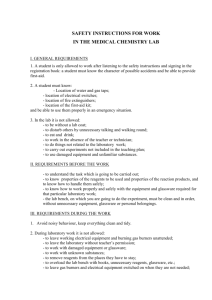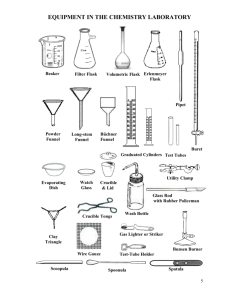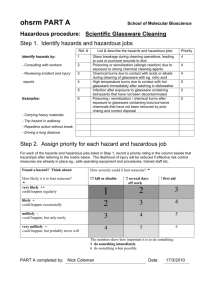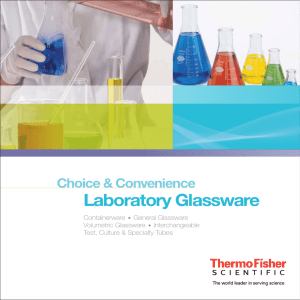Organic Chemistry 342-2016 LABNOTES-3 FEB 20
advertisement
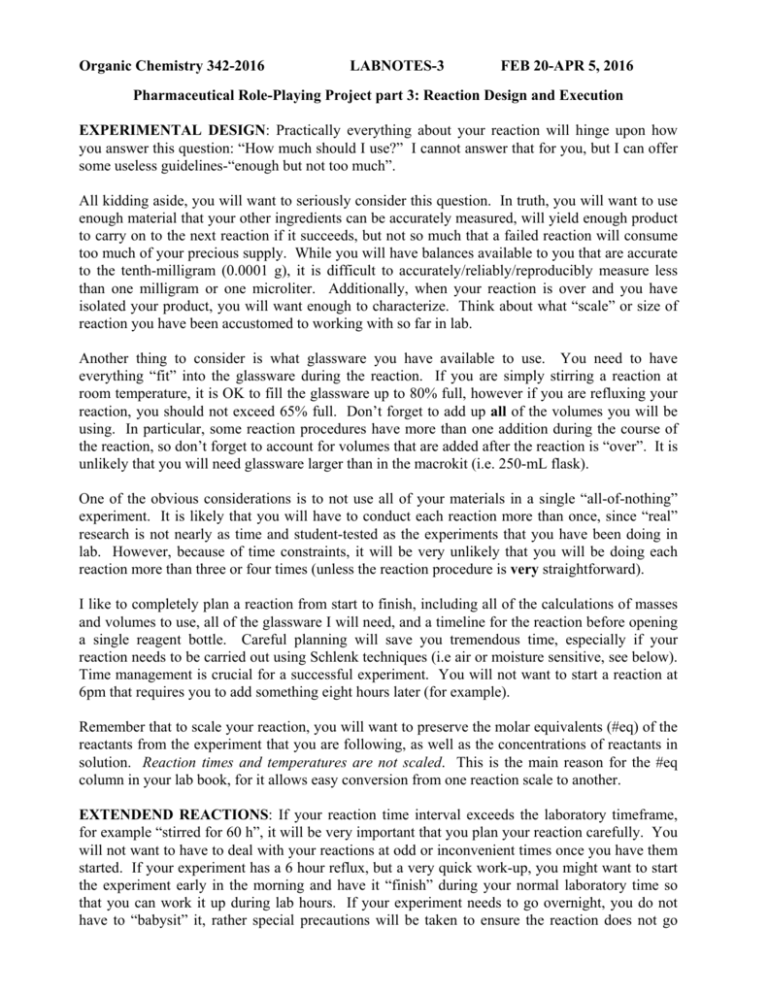
Organic Chemistry 342-2016 LABNOTES-3 FEB 20-APR 5, 2016 Pharmaceutical Role-Playing Project part 3: Reaction Design and Execution EXPERIMENTAL DESIGN: Practically everything about your reaction will hinge upon how you answer this question: “How much should I use?” I cannot answer that for you, but I can offer some useless guidelines-“enough but not too much”. All kidding aside, you will want to seriously consider this question. In truth, you will want to use enough material that your other ingredients can be accurately measured, will yield enough product to carry on to the next reaction if it succeeds, but not so much that a failed reaction will consume too much of your precious supply. While you will have balances available to you that are accurate to the tenth-milligram (0.0001 g), it is difficult to accurately/reliably/reproducibly measure less than one milligram or one microliter. Additionally, when your reaction is over and you have isolated your product, you will want enough to characterize. Think about what “scale” or size of reaction you have been accustomed to working with so far in lab. Another thing to consider is what glassware you have available to use. You need to have everything “fit” into the glassware during the reaction. If you are simply stirring a reaction at room temperature, it is OK to fill the glassware up to 80% full, however if you are refluxing your reaction, you should not exceed 65% full. Don’t forget to add up all of the volumes you will be using. In particular, some reaction procedures have more than one addition during the course of the reaction, so don’t forget to account for volumes that are added after the reaction is “over”. It is unlikely that you will need glassware larger than in the macrokit (i.e. 250-mL flask). One of the obvious considerations is to not use all of your materials in a single “all-of-nothing” experiment. It is likely that you will have to conduct each reaction more than once, since “real” research is not nearly as time and student-tested as the experiments that you have been doing in lab. However, because of time constraints, it will be very unlikely that you will be doing each reaction more than three or four times (unless the reaction procedure is very straightforward). I like to completely plan a reaction from start to finish, including all of the calculations of masses and volumes to use, all of the glassware I will need, and a timeline for the reaction before opening a single reagent bottle. Careful planning will save you tremendous time, especially if your reaction needs to be carried out using Schlenk techniques (i.e air or moisture sensitive, see below). Time management is crucial for a successful experiment. You will not want to start a reaction at 6pm that requires you to add something eight hours later (for example). Remember that to scale your reaction, you will want to preserve the molar equivalents (#eq) of the reactants from the experiment that you are following, as well as the concentrations of reactants in solution. Reaction times and temperatures are not scaled. This is the main reason for the #eq column in your lab book, for it allows easy conversion from one reaction scale to another. EXTENDEND REACTIONS: If your reaction time interval exceeds the laboratory timeframe, for example “stirred for 60 h”, it will be very important that you plan your reaction carefully. You will not want to have to deal with your reactions at odd or inconvenient times once you have them started. If your experiment has a 6 hour reflux, but a very quick work-up, you might want to start the experiment early in the morning and have it “finish” during your normal laboratory time so that you can work it up during lab hours. If your experiment needs to go overnight, you do not have to “babysit” it, rather special precautions will be taken to ensure the reaction does not go awry during the middle of the night. An example is securing the water hoses of the condenser with copper wire so that they do not pop off unexpectedly during the night and flood the computer cluster on the second floor. You will want to watch your reaction until it establishes equilibrium before leaving it unattended, since you will need to be confident it will not change during the unobserved period. This is more critical for refluxed reactions than experiments stirred at room temperature. Also if you need to maintain a heated reaction, an oil bath must be used to ensure unattended, constant temperature conditions. You should equilibrate an oil bath to your desired temperature at least one day prior to needing it. AIR/WATER-SENSITIVE REACTIONS: If your reaction is air or water sensitive (one clue is the use of dry or anhydrous solvents), it is even more critical that you meticulously plan your experiment. All of the glassware that is potentially in physical contact (including vapor) with your reaction needs to be either dried (heated) in the oven at 100oC overnight and assembled hot under dry nitrogen (don’t forget the stirring vane/bar). The reason for this is that a fine layer of water molecules are absorbed to all glass surfaces and the water molecules need to be heated off and not allowed to reabsorb to the surface if the glassware cools in the ambient atmosphere. There is a shortcut available as an alternative to overnight drying, but it is dangerous and shows poor planning on your part. Since I will have to help you learn some special techniques for this type of experiment, it will be critical that you make an appointment with me a day before you wish to do your reaction so that I can explain this technique and you are able to prepare to do it. I will also need to make sure that a Schlenk vacuum line is available to you. You might want to consider doing any “easy” reactions first before tackling the more technically challenging air-sensitive reaction. SET-UP and WORK-UP: There are two main components to reaction design/implementation: set-up and work-up. Once the reaction is completed, the procedure to isolate and purify your desired compound from the complex mixture is called the “work-up”. It tends to be the most difficult portion of synthetic chemistry if you do not have literature precedent for “fishing” your compound out of the reaction mixture. Two common techniques that you have yet to use in a work-up procedure are rotary evaporation, sometimes called solvent removal in vacuo or under reduced pressure, and column chromatography. We have access to both, but hopefully your product will be pure enough to avoid column chromatography. TIME-MANAGEMENT: Since most reactions are dangerous, and students need to know someone is available to help in an emergency situation, it is very important that you realize that I need to be present in the department when you are conducting your reactions. That means that you must plan your laboratory time with my schedule in mind. Please remember that I have obligations outside of Concordia, and that spending time with my wife and daughter is important to me. I will try to be accommodating when I can – and I will ask that you do the same. When planning your lab time, please try to adhere to the following guidelines: - I MUST be in the lab (or thereabouts) when you are physically in the lab (i.e. setting up a reaction, working up a reaction), but I do not need to be around if you are taking melting points, running the GC/MS, taking IR or NMR spectra, or if the reaction is running overnight. It is my hope that you will be able to do everything during your scheduled lab time, and this is why serious thought about choosing your reactions is so important. You will need to check with me/give me advance notice if you plan to do any work outside of lab times. My daily schedule is available online and on my office door if you need to check my availability during normal working hours. I am willing to - - - extend the lab hours if I am available, but I will need advance notice (24 hour or more) to arrange it, and even then it may not be possible in some situations. The scheduled lab times are fair game for any company regardless of whether it is “your” lab time. However if things get too congested, crowded or dangerous and those companies that are using “their” lab time are unable to work productively, I will have to dismiss interlopers. All reactions should be planned out so that they are started and completed during reasonable hours (i.e. no reactions should be started before 8:30 a.m., and the lab should be vacated no later than 6 p.m., unless other arrangements have been made with me prior to the need). Julie and Eliana appreciate your consideration of my time… Both organic chemists must be present during the setup and workup, but not necessarily while the reaction is “cooking” ANALYSIS: Once you have your product in hand and wish to analyze it, the analytical chemist will need to take an 1H/13C-NMR of the sample first. The reason for this is that injecting water, acids or “dirty” samples into the GC/MS will significantly damage the instruments. Once the analytical chemist can verify to me that your sample is injectable (a NMR spectra) then I will allow her to use the GC/MS to analyze your reactions products.
